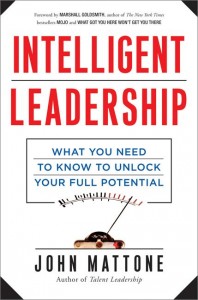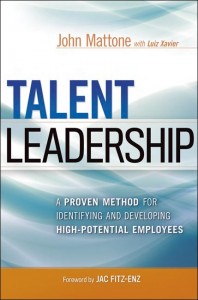I’m always on the hunt for great leadership books, thinkers, and ideas. A few months ago, I was introduced to John Mattone’s work. John is the author of Talent Leadership, and he has recently released Intelligent Leadership.
 Intelligent Leadership reinforces key success concepts and adds to your leadership arsenal with new tools developed from John’s research and extensive work as a leadership coach. It’s one of those books that will help you better understand yourself and others, insuring greater success.
Intelligent Leadership reinforces key success concepts and adds to your leadership arsenal with new tools developed from John’s research and extensive work as a leadership coach. It’s one of those books that will help you better understand yourself and others, insuring greater success.
John, you developed a model for leadership you call the Leadership Wheel of Success. I will point readers to the book for a detailed explanation, but let’s just focus on the outer core for a moment. You identify nine specific leadership skills required for a successful leader. How did you develop this model?
Skip, the notion that the definition of a target of leadership success is different for every leader and organization led to the explosion of competency-modeling work primarily in the 1980s and early 1990s. Every organization was creating its own targets of leadership success. Of course, this led to the rise of consulting and research firms who took advantage of real market needs to help these organizations research and define leadership success in their own unique organization for their own unique leaders. The result? We have learned that the definition of leadership success—the leadership success target comprised of leadership can-do, will-do, and must-do—is really not all that unique to a particular leader or organization. In the process, through years of research, we have gained tremendous intelligence about leadership success and the competencies that define success. The early leadership competency work done by David McLeland and McBer and Company, as well as the more recent work of the Center for Creative Leadership, John Kotter, Lominger, my own firm, and hundreds of other notable researchers and leading thinkers has added not only a unique perspective but also a corroborative perspective that there is value in creating a universal target of leadership success.
Would you touch on the inner core and why it’s so critical to focus on?

The inner core consists of the intrapersonal (i.e., self-concept, character, values, references, beliefs, thoughts, emotions) and interpersonal elements (i.e., behavioral tendencies) that strongly impact how effectively you acquire and cultivate the nine outer-core leadership competencies. Usually, people see, experience, and pass judgment on your outer core. The inner core, though critical in driving the outer core, is hidden. People don’t observe your self-image, beliefs and references. They observe only your behavior. Predictive relationships exist between your inner and outer core. If you possess a strong inner core, you have a heightened capability to acquire, grow, and mature in the development and evidence of the competencies and skills comprising the outer core.
Another unique tool in the book is the Map of Leadership Maturity. You identify nine different types of leaders:
- The Perfectionist
- The Helper
- The Entertainer
- The Artist
- The Thinker
- The Disciple
- The Activist
- The Driver
- The Arbitrator
I haven’t met anyone who doesn’t enjoy figuring out his or her primary style, then analyzing the boss. Would you take us through “The Map” to give us a flavor of how it works?
Of course! The Map of Leadership Maturity grew from my earlier research and consulting work in the middle 1990s and my first book, Success Yourself, which I believe was the first book written applying the concepts of the Enneagram to the world of business. In the past 15 years, I have refined my ideas and concepts based on my continuing research as well as my experiences coaching over 250 leaders in that time. “The Map” is a powerful tool that provides leaders with the framework and roadmap for exploring and distinguishing between the nine distinct predominant traits defining great leadership. It helps leaders gain a granular understanding of the degree of maturity that they must possess in the values, thoughts, emotions, and behaviors of their own predominant trait as well as in the other eight traits that comprise their unique leadership fingerprint. They learn that being a successful leader is less a function of their predominant trait and much more a function of the relative maturity with which they evidence that predominant trait—and each of their other eight traits. They learn specific strategies on how they can strengthen their maturity within all their traits. They also learn specific strategies for building rapport, trust, and credibility with individuals who present a different predominant trait from theirs. In addition to learning key insights about their leadership styles, they build knowledge and skills so that they can more successfully lead different style types. Ultimately, in writing this book, my sincere desire is that leaders and future leaders begin to recognize, appreciate, and internalize that unlocking and unleashing their own leadership potential is a function of possessing a passionate and diligent desire to:
- Discover their unique development goals and strategic developmental pathways.
- Begin executing these strategies with passion and focus.
- Learn and course-correct continuously as they execute with passion and focus.
What are you seeing as you work with leaders from all industries with these new tools? Anything surprising? Do most people know where they fit?
Yes, most people are pretty accurate in identifying their predominant trait, however, they are not nearly as accurate in identifying their maturity levels. For example, if a particular leader discovers that their predominant trait is “Perfectionist”, they get excited because the assessment in the book, “The Mattone Leadership Enneagram Inventory (MLEI),” has confirmed what they already knew about themselves. But, the key to leadership growth and growth in general is uncovering four areas:
(1) indisputable strengths
(2) indisputable development needs
(3) surprise strengths; and
(4) surprise development needs.
The MLEI assessment (inner core assessment) combined with a multi-rater or 360 leadership assessment (outer core assessment) provides the pathway for all leaders and future leaders to clearly identify these four areas. In my experience, the absolute key to a leader unlocking their potential is in identifying the “surprises”…both positive and negative. So, back to the Perfectionist example: While they are excited that the MLEI has accurately identified their predominant trait, they may become surprised that the MLEI has also identified that they possess more immature elements of perfectionism (i.e., dogmatic, inflexible, enjoy proving others wrong, unattainable goals, can “rationalize” their actions to maintain their “logical” position, can be cruel and sadistic) as opposed to the more mature elements (i.e., self-disciplined, realistic goals, can tolerate others’ shortcomings, can evaluate problems and determine priorities). This becomes an important breakthrough for leaders to discover. Most organizations in their leadership development efforts are falling short when it comes to having leaders and future leaders “look inside” at the health and vibrancy of their inner core. We need to do a better job at helping leaders and future leaders become “vulnerable”…in my experience working with executives it is vital that we help them come to grips with the fact that while they might be effective leaders and future leaders….they are not the absolute best they can be. When a leader accepts and internalizes this sometimes difficult truth, this becomes the first step to unlocking their greatness as a leader.
Thanks, Skip!

